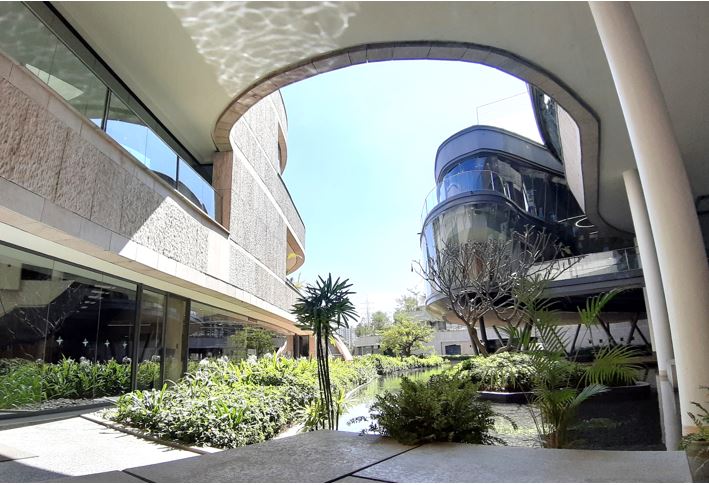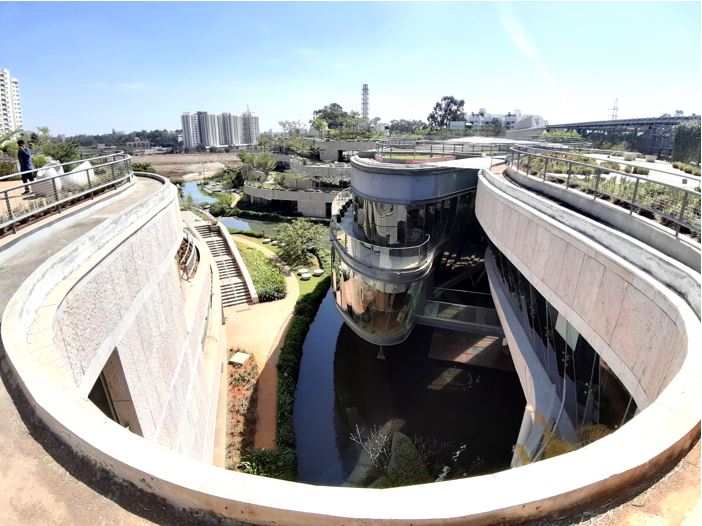Titan campus in Bangalore
Contents |
[edit] Introduction
Greenery is often lacking in many developed urban cities. Tall skyscrapers create a jungle of concrete; this is what human beings have made in the few last decades.
Instead, is it possible to make buildings that become a part of nature by merging the green and the IoT world?
At the the Titan Integrity Campus in Bangalore, architects applied this strategy to create a building that integrates with nature. The project resulted in a 30% reduction in energy consumption and also achieved a five-star Green Rating for Integrated Habitat Assessment (GRIHA).
[edit] Bringing nature inside
The longer sides of the building face north, which brings in glare-free natural light. The interior of the building also has light sensors to balance the environment with sunlight and control the appropriate levels for the working environment.
The breeze passes through the building so common spaces are open and do not require air conditioning. To cut off the western sun, green walls and green buffer spaces are created for a non-obstructing workflow.
What makes this building different is not just its biophilic design but also the reflection of the architect’s love for curves and parametric design.The lake around the building gives office workers the sense they are in a zone to play and work, and they are free to roam around the building through long pathways linking all the floors and different blocks.
Material selection and green construction techniques (such as topsoil conservation and reuse of gunny bags for column curing) add to the building's environmentally sensitive approach.
[edit] Related articles on Designing Buildings Wiki
- Biophilic design.
- Biotechnology: The key to zero energy buildings.
- Environmental - sustainable - green design.
- Green building.
- Sustainability.
[edit] External references
Featured articles and news
The UK's Modern Industrial Strategy: A 10 year plan
Previous consultation criticism, current key elements and general support with some persisting reservations.
Building Safety Regulator reforms
New roles, new staff and a new fast track service pave the way for a single construction regulator.
Architectural Technologist CPDs and Communications
CIAT CPD… and how you can do it!
Cooling centres and cool spaces
Managing extreme heat in cities by directing the public to places for heat stress relief and water sources.
Winter gardens: A brief history and warm variations
Extending the season with glass in different forms and terms.
Restoring Great Yarmouth's Winter Gardens
Transforming one of the least sustainable constructions imaginable.
Construction Skills Mission Board launch sector drive
Newly formed government and industry collaboration set strategy for recruiting an additional 100,000 construction workers a year.
New Architects Code comes into effect in September 2025
ARB Architects Code of Conduct and Practice available with ongoing consultation regarding guidance.
Welsh Skills Body (Medr) launches ambitious plan
The new skills body brings together funding and regulation of tertiary education and research for the devolved nation.
Paul Gandy FCIOB announced as next CIOB President
Former Tilbury Douglas CEO takes helm.
UK Infrastructure: A 10 Year Strategy. In brief with reactions
With the National Infrastructure and Service Transformation Authority (NISTA).
Ebenezer Howard: inventor of the garden city. Book review.
The Grenfell Tower fire, eight years on
A time to pause and reflect as Dubai tower block fire reported just before anniversary.
Airtightness Topic Guide BSRIA TG 27/2025
Explaining the basics of airtightness, what it is, why it's important, when it's required and how it's carried out.
Construction contract awards hit lowest point of 2025
Plummeting for second consecutive month, intensifying concerns for housing and infrastructure goals.
Understanding Mental Health in the Built Environment 2025
Examining the state of mental health in construction, shedding light on levels of stress, anxiety and depression.























